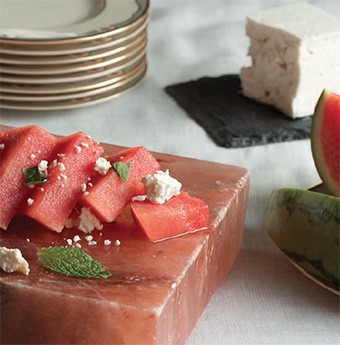Salt of the earth (and sea and mountains)
March 18, 2015 by Darcie If you spend any time perusing old recipe books,
you’ll be hard pressed to find any other description for salt other
than “salt.” In contrast, today’s cookbooks might make reference to
a dozen types of salt. Maria Fitzpatrick of The Wall Street
Journal takes a look at how this once humble ingredient rose to star status.
If you spend any time perusing old recipe books,
you’ll be hard pressed to find any other description for salt other
than “salt.” In contrast, today’s cookbooks might make reference to
a dozen types of salt. Maria Fitzpatrick of The Wall Street
Journal takes a look at how this once humble ingredient rose to star status.
Fitzpatrick traces the rise of specialty salts to Ferran Adria and El Bulli in the mid 1990s. Adria needed the finishing touch for his new deconstructed lasagna, so he called a small, historic, family-run saltworks in Maldon, England. He asked for “one case of their finest crystals, in perfectly uniform but oversize pyramid shapes, individually wrapped in cotton wool.”
And as with most culinary trends, it found its way from restaurants to home kitchens. According to David Turner, global food and drink analyst at market-research firm Mintel, there’s been a marked jump in premium salts coming to market world-wide-22% more in 2014 compared with a year earlier.
Not all foodies are buying it, though. “In my view, the vogue for funky salts is rather unnecessary,” says Annie Gray, a U.K.-based food historian, consultant and broadcaster. “The nice colors may be pretty, but at the end of the day, it’s still the same chemical.”
But for others, salt lives up to its hype. It’s all helped along by the resurgence of age-old preservation methods such as curing and pickling, which involve not only a lot more salt but an “inescapable appreciation for the difference the right [salt] makes,” says Andrew Turner, executive head chef at London’s Hotel Café Royal. “The key to exciting results, whatever you’re cooking, is in the salt’s purity,” he says. “The beauty is, if the quality is that good, you can use less of it.”
While the number of salts keeps growing, ranging from exotic Himalayan pink salt to oak-smoked sea salt, Food Republic gets you started with the five types of salt every cook should know. From there you can progress to recipes in the EYB Library that call for smoked salt or Himalayan pink salt. The latter is sometimes used in block form as in the Watermelon and feta on a salt block (pictured above) from Salt Block Cooking.
Categories
- All Posts (7077)
- Antipasto (2207)
- Author Articles (250)
- Book News (944)
- Cookbook Giveaways (996)
- Cookbook Lovers (262)
- Cooking Tips (116)
- Culinary News (299)
- Food Biz People (558)
- Food Online (800)
- Holidays & Celebrations (277)
- New Cookbooks (154)
- Recipes (1520)
- Shelf Life With Susie (231)
- What's New on EYB (134)
Archives
Latest Comments
- Kisa on French at Heart – Cookbook Giveaway
- smcculle on French at Heart – Cookbook Giveaway
- SULouisville on Balli Balli – Cookbook Giveaway and Quick Bites
- SULouisville on 20 Amici – 40 Ricette Cookbook Giveaway
- SULouisville on French at Heart – Cookbook Giveaway
- SULouisville on French at Heart – Cookbook Giveaway
- JimCampbell on Food news antipasto
- Indio32 on Four outstanding independently published cookbooks worth your attention
- nvernon on Four outstanding independently published cookbooks worth your attention
- fayegibson on Four outstanding independently published cookbooks worth your attention